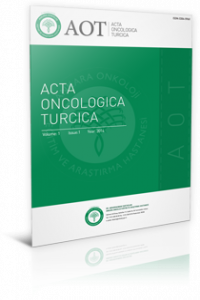Evaluation of Cultures Obtained from Cancer Patients During Febrile Neutropenia
Febril nötropeni, febril nötropenide kültürler, kanser.
Kanserli Hastalarda Febril Nötropeni Sırasında Alınan Kültürlerin Değerlendirilmesi
Febrile neutropenia, cultures in febrile neutropenia, cancer.,
___
- Mandell, Douglas, Bennett’s Principles of Infectious Disea- ses. 6* ed. Churchill Livingstone, 2005:3421-30.
- Picazo JJ. Management of the febrile neutropenic patient: a consensus conterence. Clin Infect Dis 2004; 39:S1.
- Pizzo PA. Management of fever in patients with cancer and tre- atment-induced neutropenia. NEngiJMed 1993; 328:1323-32.
- Healey T, Nayagam S. Retrospective review of febrile neutro penia in the Royal Darwin Hospital, 1994-99. Internal Medici- ne Journal 2001; 31:406-12.
- Poyart C, Morand P, Buzyn A. Etiologie des infections bacteri- ennes chez les patients neutropeniques febriles. Presse Med 2004; 33:460-6.
- Kanamaru A, Tatsumi Y. Microbiological data for patients with febrile neutropenia. İD 2004; 39(Suppl 1):7-10.
- Butt T, Afraz RK, Ahmad RN, Salman M, Mahmood A, Anwar M. Bloodstream infections in febrile neutropenic patients: bac- terial spectrum and antimicrobial susceptibility pattern. JAyub Med Coll Abbottabad 2004; 16:18-22.
- Rintana E Incidence and clinical significance of positive blood cultures in febrile episodes of patients with hematological ma- iignancies. Scand J infect Dis 1994; 26:77-84.
- Duzova A, Kutluk T, Karna G, et al. combination therapy with piperacillin plus amikacin as ampiric therapy for neutropenic fever children with lymphoma and solid tumors. The Turkish Journal of Pediatrics 2001; 43:105-9.
- At-Fawaz İM, Kam bal AM, Ai-Rabeeah AA, et al. Septicaemia in febrile neutropenic children with cancer in Saudi Arabia. J Hospital İnfect 1991; 18:307-12.
- ISSN: 0304-596X
- Başlangıç: 2015
- Yayıncı: Dr. Abdurrahman Yurtaslan Ankara Onkoloji EAH
Association of Carcinoma of the Breast and Meningioma: Report of a Case and Review of the Literature
Yasemin Benderli CİHAN, Figen Figen ÖZTÜRK
Bladder Tumor Metastatic to the Bones of the Foot: A Case Report
Yasemin CİHAN, Mustafa SOFİKERİM, Kemal DENİZ
Özlem Şahin BALÇIK, Nafiye HELVACI, Murat ALBAYRAK, Osman YOKUŞ, Funda CERAN, Simten DAĞDAŞ, Gülsüm ÖZET
Primary Nasal Cavity Malignant Melanoma Presenting with Epistaxis
Güze ÖZAL, Mutlu DOĞAN, Gülşah KAYGUSUZ, Güngör UTKAN, Bülent YALÇIN, Fikri İÇLİ
Temporary Central Venous Catheter Placement with Radiological Imaging
Doğan DEDE, Ahmet AVLUK, Nilgün YILDIRIM, İlkay AKMANGİT, Bige Sayin SEVER
Azer R ALİYEV, Rashad S ZEYNALOV
Evaluation of Cultures Obtained from Cancer Patients During Febrile Neutropenia
Gülşen İSKENDER, Kamuran SAYILIR, Mustafa Cihat OĞAN, Müfide ÇİMENTEPE, Ayla YENİGÜN, Sema BATI
Primary Submandibular Gland Malign Mucosa Associated Lymphoid Tissue (MALT) Lymphoma: Case Report
Ferhat BOZKUŞ, İsmail İYNEN, İmran ŞAN, Muhammet Emin GÜLDÜR
Unusual Presentation of Hepatocellular Carcinoma That Mimics Epigastric Hernia: A Case Report
Melih AKINCI, Zafer ERGÜL, Kerim Bora YILMAZ, Engin ÖLÇÜCÜOĞLU, Hakan KULAÇOĞLU
Our Experience in Provox Voice Protheses for Voice Restoration After Total Laryngectomy
Fadlullah AKSOY, Bayram VEYSELLER, Yavuz Selim YILDIRIM, Hasan DEMİRHAN, Orhan ÖZTURAN
